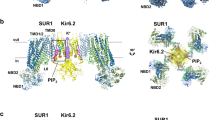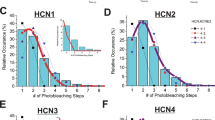Abstract
POTASSIUM channels that are ATP-sensitive (KATP) couple membrane potential to the metabolic status of the cell. KATP channels are inhibited by intracellular ATP and are stimulated by intracellular nucleotide diphosphates1. KATP channels are important regulators of secretory processes and muscle contraction, and are targets for therapeutic treatment of type II diabetes by the inhibitory sulphonylureas2 and for hypertension by activators such as pinacidil3. In cardiac tissue, KATP channels are central regulators of post-ischaemic cardioprotection4,5. Electrophysiological and pharmacological characteristics vary among KATP channels recorded from diverse tissues suggesting extensive molecular heterogeneity1. A complementary DNA encoding a KATP channel was isolated from rat heart using the polymerase chain reaction. We report here that the expressed channels possess all of the essential features of native cardiac KATP channels, including sensitivity to intracellular nucleotides. In addition the cloned channels are activated by the potassium channel opener, pinacidil, but are not inhibited by the sulphonylurea, glibenclamide.
This is a preview of subscription content, access via your institution
Access options
Subscribe to this journal
Receive 51 print issues and online access
$199.00 per year
only $3.90 per issue
Buy this article
- Purchase on Springer Link
- Instant access to full article PDF
Prices may be subject to local taxes which are calculated during checkout
Similar content being viewed by others
References
Ashcroft, F. M. A. Rev. Neurosci. 11, 97–118 (1988).
Gopalakrishnan, M., Janis, R. A. & Triggle, D. J. Drug Dev. Res. 28, 95–127 (1993).
Friedel, H. A. & Brogden, R. N. Drugs 39, 929–967 (1990).
Lynch, J. J. Jr, Sanguinetti, M. C., Kimura, S. & Bassett, A. L. FASEB J. 6, 2952–2960 (1992).
Escande, D. & Cavero, I. Trends pharmacol. Sci. 13, 269–272 (1992).
Kubo, Y., Baldwin, T. J., Jan, Y. N. & Jan, L. Y. Nature 362, 127–133 (1993).
Ho, K. et al. Nature 362, 31–38 (1993).
Dascal, N. et al. Proc. natn. Acad. Sci. U.S.A. 90, 6596–6600 (1993).
Kubo, Y., Reuveny, E., Slesinger, P. A., Jan, Y. N. & Jan, L. Y. Nature 364, 802–806 (1993).
Lederer, W. J. & Nichols, C. G. J. Physiol. 419, 193–211 (1989).
Tung, R. T. & Kurachi, Y. J. Physiol. 437, 239–256 (1991).
Findlay, I. Biochim. biophys. Acta 943, 297–304 (1988).
Trube, G. & Hescheler, J. Pflügers Arch. 401, 178–184 (1984).
Zilberter, Y., Burnashev, N., Papin, A., Portnov, V. & Khodorov, B. Pflügers Arch. 411, 584–589 (1988).
Findlay, I. J. Pharmacol. exp. Ther. 261, 540–545 (1992).
Edwards, G. & Weston, A. H. A. Rev. Pharmacol. Toxicol. 33, 597–637 (1993).
Fan, Z., Nakayama, K. & Hiraoka, M. J. Physiol. 430, 273–295 (1990).
Saraste, M., Sibbald, P. R. & Wittinghofer, A. Trends biol. Sci. 15, 430–434 (1990).
Aldrich, R. Nature 362, 107–108 (1993).
Khan, R. N., Hales, C. N., Ozanne, S. E., Adogu, A. A. & Ashford, M. L. J. Proc. R. Soc. 253, 225–231 (1993).
Lee, K., Ozanne, S. E., Hales, C. N. & Ashford, M. L. J. Br. J. Pharmacol. 111, 632–640 (1994).
Bond, C. T. et al. Recept. Channels (in the press).
Frohman, M. A., Dush, M. K. & Martin, G. R. Proc. natn. Acad. Sci. U.S.A. 86, 8998–9002 (1988).
Hamill, O. P., Marty, A., Neher, E., Sakmann, B. & Sigworth, F. Pflügers Arch. 391, 85–100 (1981).
Dempster, J. Computer Analysis of Electrophysiological Signals (Academic, London, 1993).
Author information
Authors and Affiliations
Rights and permissions
About this article
Cite this article
Ashford, M., Bond, C., Blair, T. et al. Cloning and functional expression of a rat heart KATP channel. Nature 370, 456–459 (1994). https://doi.org/10.1038/370456a0
Received:
Accepted:
Issue Date:
DOI: https://doi.org/10.1038/370456a0
This article is cited by
-
Modulation of KATP currents in rat ventricular myocytes by hypoxia and a redox reaction
Acta Pharmacologica Sinica (2009)
-
Inhibition of an inwardly rectifying K+ channel by G-protein α-subunits
Nature (1996)
-
Cell-type specificity of preconditioning in an in vitro model
Basic Research in Cardiology (1996)
-
The Ba2+ block of the ATP-sensitive K+ current of mouse pancreaticβ-cells
Pflügers Archiv European Journal of Physiology (1996)
Comments
By submitting a comment you agree to abide by our Terms and Community Guidelines. If you find something abusive or that does not comply with our terms or guidelines please flag it as inappropriate.



